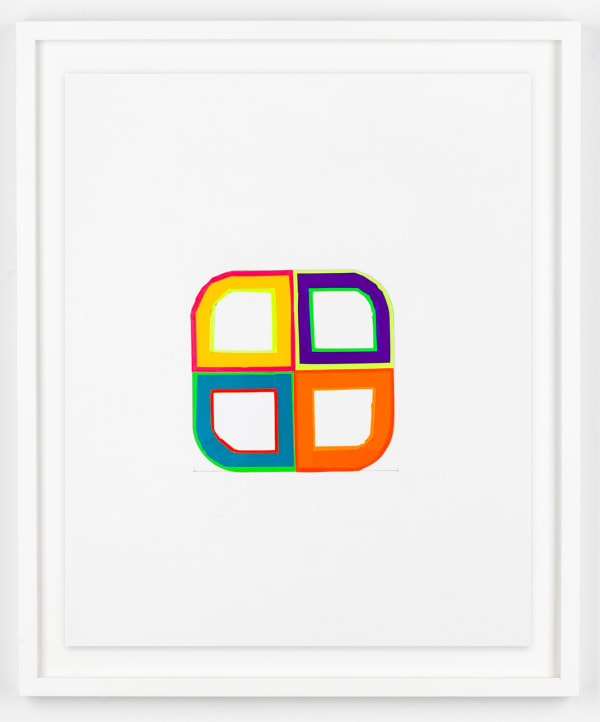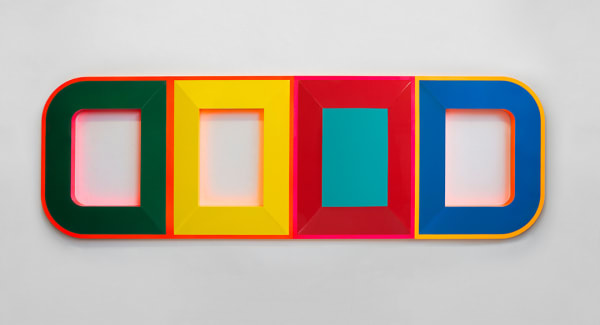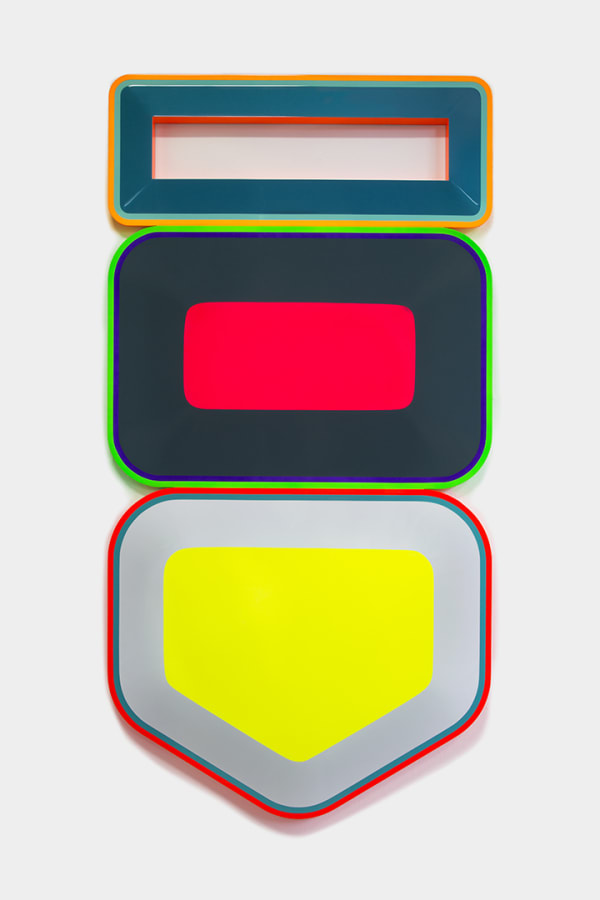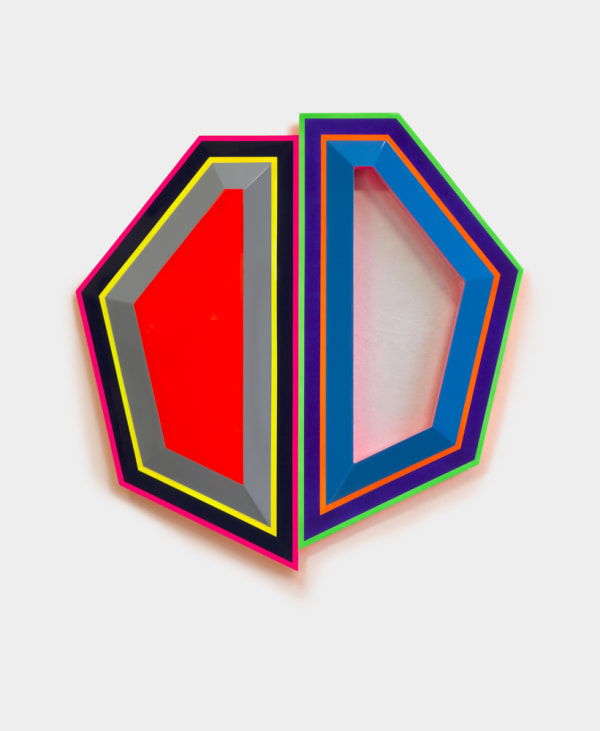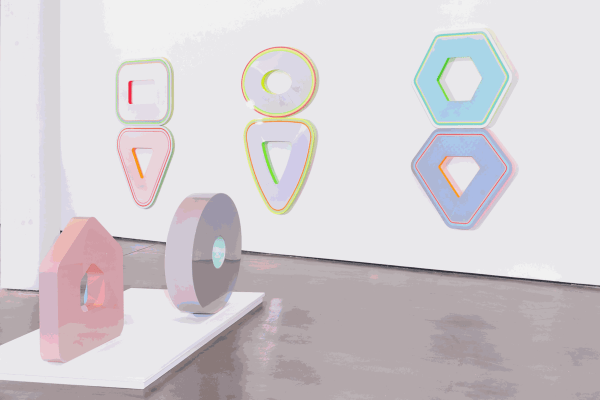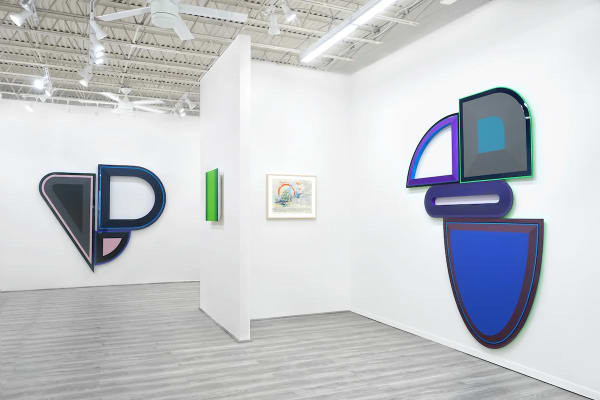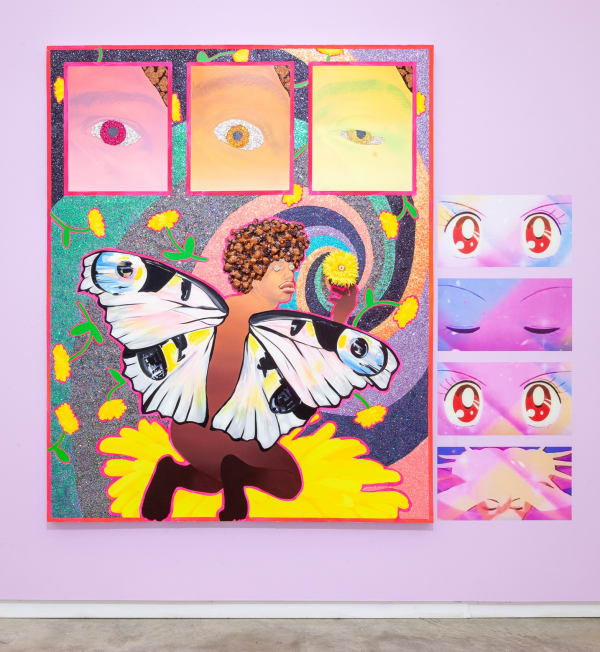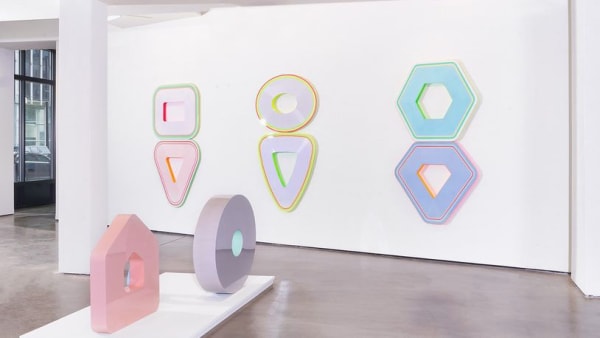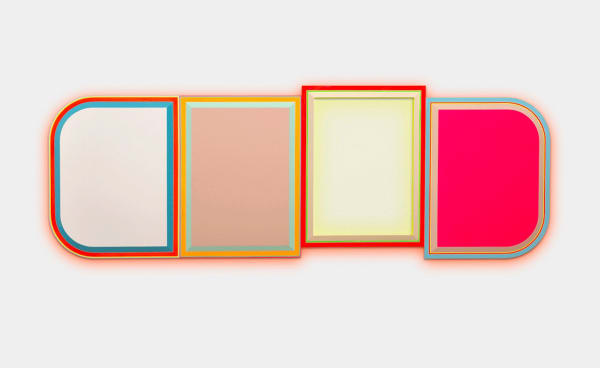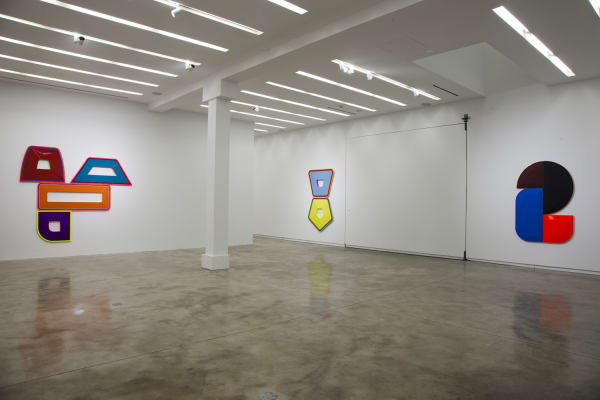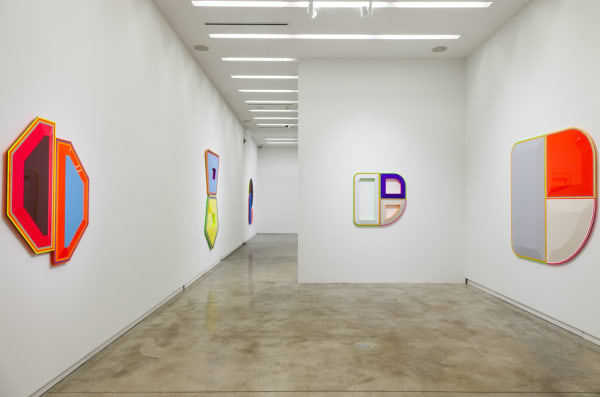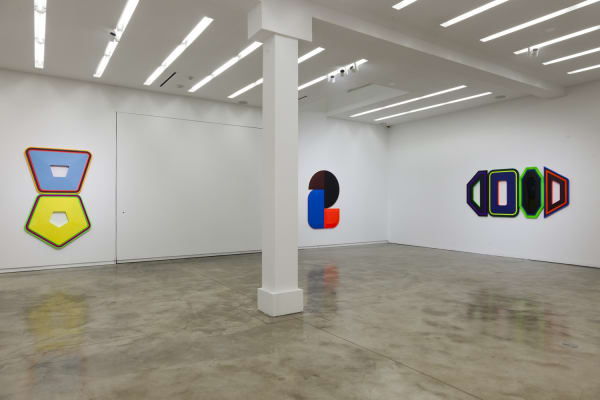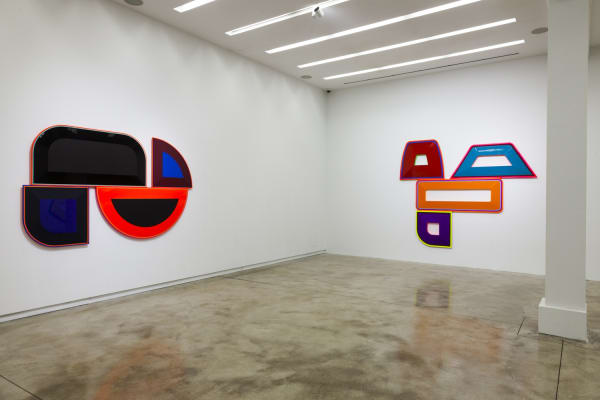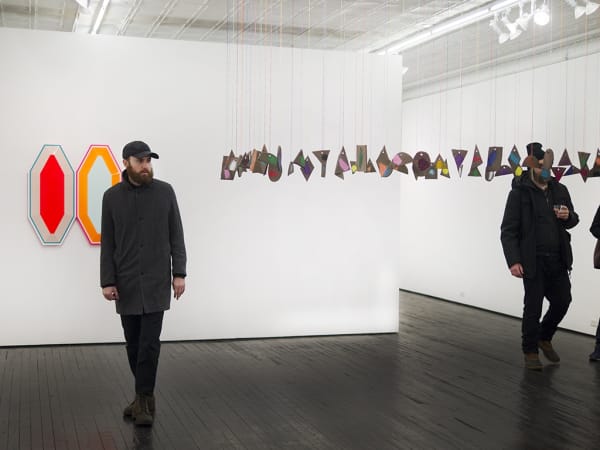Beverly Fishman American, b. 1955
Beverly Fishman is a leading protagonist in the field of politically activated abstract art. An Anonymous Was A Woman Award Winner, John Simon Guggenheim Memorial Foundation Fellow, and National Endowment for the Arts Grantee, Fishman dedicates her studio practice to an aesthetic examination of people’s relationship with the business, politics and chemistry of healing.
For decades, Fishman's research has focused on the visual vocabulary that pharmaceutical designers deploy in their calculated efforts to market antidepressants, anxiolytics, amphetamines, anti-inflammatories, beta blockers, opioids, and other chemicals to the masses. Morphed and elevated by Fishman in her studio, these medicinal motifs become the building blocks for ecstatic, abstract visual cocktails that open doors to the aesthetic sublime.
Fishman’s luminescent, geometric relief paintings beguile the eyes. Along with their radiant material presence, their uncanny structures challenge viewers to look beyond the surface, to try to recall where it was that they have seen these curious shapes before. Epiphany is aided by the titles Fishman gives her paintings, which invoke a litany of ills, such as depression, high blood pressure, bipolar disorder, opioid addiction, insomnia, and ADHD—these are pharmaceutical forms, abstracted from the pills we ingest every day to balance our bodies and minds.
Formal conceptual concerns related to movements such as Minimalism and Light and Space also guide Fishman’s practice, as does intuition. Among her most masterful aesthetic faculties is Fishman’s ability to create specialized, highly emotive color worlds for her exhibitions.
“I think about the totality of the experience of the color,” Fishman says. “Color is mysterious to me.”
Fishman’s materials list has included traditional supports, such as wood, paper, blown glass and aluminum, as well as unconventional elements, like cast resin, mirrored Plexiglass, powder-coated metal, and phosphorescent pigments. She also frequently uses mediums like chrome and urethane automotive paint that speak to the legacy of the Detroit area, where she lives and works.
The highly reflective automotive paint gives her paintings such highly polished surfaces that they seem to glow. That iridescent light radiates into the empty spaces in the forms, creating transcendent zones that speak both literally and metaphorically to the potential of voids. Like all important achievements in symbolism, Fishman’s pill reliefs transmit lasting truths about the human condition to those literate and brave enough to read between the shapes.
One in five Americans today lives with chronic pain. One in seven lives with some kind of anxiety disorder.
Fishman’s phosphorescent blasts of geometric lucidity illuminate the shadowy battleground on which we fight against an unchecked Pharmaceutical Industrial Complex, to assert the right to understand and define our own bodies and identities.
“Pharmaceuticals intersect with feminism,” Fishman says. “Women were given Valium for their nerves. Why were they nervous? Were they unsatisfied with their lives, with their options? They were anesthetizing an entire generation. Our culture’s relationship to medicine and science is complex. I’m in the unknown. Can abstraction be political and socially relevant? These are things I’ve always thought were important in my work.”
Recent major exhibitions of Fishman's work include FEELS LIKE LOVE, Kavi Gupta, Chicago, IL; Recovery, Eli and Edythe Broad Art Museum, East Lansing, MI, USA; I Dream of Sleep, Miles McEnery, New York, NY, USA; Future Perfect, Kavi Gupta, Chicago, IL, USA; Double Edged: Geometric Abstraction Then and Now, curated by Dr. Emily Stamey, Weatherspoon Art Museum, Greensboro, NC, USA; DOSE, curated by Nick Cave, CUE Art Foundation, New York, NY, USA; Pill Spill, Detroit Institute of Art, Detroit, MI, USA; and Beverly Fishman: In Sickness and in Health, Chrysler Museum of Art, Norfolk, VA, USA. Fishman has received numerous awards, including the 2018 Anonymous Was A Woman Award; the John Simon Guggenheim Memorial Foundation Fellowship; and the NEA Fellowship Grant. Work by Fishman is included in the collections of the MacArthur Foundation, the Detroit Institute of Arts, the Columbus Museum of Art, the Chrysler Museum of Art, and many others. Fishman served as the head of painting and as artist-in-residence at the Cranbrook Academy of Art for twenty-seven years.
-
 Beverly FishmanUntitled (pain, birth control, adhd), 2023Urethane paint on wood43 x 41 in
Beverly FishmanUntitled (pain, birth control, adhd), 2023Urethane paint on wood43 x 41 in
109.2 x 104.1 cm -
 Beverly FishmanUntitled (Depression, Anxiety, ADHD), 2021Urethane paint on wood44 x 44.8 x 2 in
Beverly FishmanUntitled (Depression, Anxiety, ADHD), 2021Urethane paint on wood44 x 44.8 x 2 in
111.8 x 113.7 x 5.1 cm -
 Beverly FishmanUntilted, 2020Paint on MDF13 x 12.3 x 3.8 in
Beverly FishmanUntilted, 2020Paint on MDF13 x 12.3 x 3.8 in
33 x 31.8 x 9.5 cm -
 Beverly FishmanUntitled, 2020Collage on paper19 x 24 in (48.3 x 61 cm) Unframed, digital frame added
Beverly FishmanUntitled, 2020Collage on paper19 x 24 in (48.3 x 61 cm) Unframed, digital frame added
-
 Beverly FishmanUntitled, 2020Collage on paper17 x 14 in (43.2 x 35.6 cm)
Beverly FishmanUntitled, 2020Collage on paper17 x 14 in (43.2 x 35.6 cm)
Unframed, digital frame added -
 Beverly FishmanUntitled, 2020Collage on paper17 x 14 in (43.2 x 35.6 cm)
Beverly FishmanUntitled, 2020Collage on paper17 x 14 in (43.2 x 35.6 cm)
Unframed, digital frame added
-
 Beverly FishmanUntitled, 2020Collage on paper17 x 14 in (43.2 x 35.6 cm)
Beverly FishmanUntitled, 2020Collage on paper17 x 14 in (43.2 x 35.6 cm)
Unframed, digital frame added
-
 Beverly FishmanUntitled, 2020Collage on paper17 x 14 in (43.2 x 35.6 cm)
Beverly FishmanUntitled, 2020Collage on paper17 x 14 in (43.2 x 35.6 cm)
Unframed, digital frame added
-
 Beverly FishmanUntitled (Opioid Addiction, open depression), 2020Urethane paint on wood43 x 36 x 2 in
Beverly FishmanUntitled (Opioid Addiction, open depression), 2020Urethane paint on wood43 x 36 x 2 in
109.2 x 91.4 x 5.1 cm -
 Beverly FishmanUntitled (Alcoholism), 2019Urethane paint on wood42 x 39 x 2 in
Beverly FishmanUntitled (Alcoholism), 2019Urethane paint on wood42 x 39 x 2 in
106.7 x 99.1 x 5.1 cm -
 Beverly FishmanUntitled (ADHD, Alcoholism, Opioid Addiction), 2018Urethane paint on wood72 x 51.5 x 2 in
Beverly FishmanUntitled (ADHD, Alcoholism, Opioid Addiction), 2018Urethane paint on wood72 x 51.5 x 2 in
182.9 x 130.8 x 5.1 cm -
 Beverly FishmanUntitled (Anxiety), 2018Urethane paint on wood39 x 29 x 2 in
Beverly FishmanUntitled (Anxiety), 2018Urethane paint on wood39 x 29 x 2 in
99.1 x 73.7 x 5.1 cm -
 Beverly FishmanUntitled (Digestive Problems/Anxiety), 2018Urethane on wood42.5 x 43 x 2 in
Beverly FishmanUntitled (Digestive Problems/Anxiety), 2018Urethane on wood42.5 x 43 x 2 in
107.3 x 109.2 x 5.1 cm -
 Beverly FishmanUntitled (Stacked a+c), 2018Urethane paint on wood41 x 34 x 2 in
Beverly FishmanUntitled (Stacked a+c), 2018Urethane paint on wood41 x 34 x 2 in
104.1 x 86.4 x 5.1 cm -
 Beverly FishmanUntitled (Alcoholism, Antipsychotic, Pain, High Blood Pressure), 2017Urethane paint on wood50 x 103.8 x 2 in
Beverly FishmanUntitled (Alcoholism, Antipsychotic, Pain, High Blood Pressure), 2017Urethane paint on wood50 x 103.8 x 2 in
127 x 263.7 x 5.1 cm -
 Beverly FishmanUntitled (Anxiety), 2017Urethane paint on wood56 x 126 x 2 in
Beverly FishmanUntitled (Anxiety), 2017Urethane paint on wood56 x 126 x 2 in
142.2 x 320 x 5.1 cm -
 Beverly FishmanUntitled (Anxiety, Three Missing Doses), 2017Urethane paint on wood39 x 126 x 2 in
Beverly FishmanUntitled (Anxiety, Three Missing Doses), 2017Urethane paint on wood39 x 126 x 2 in
99.1 x 320 x 5.1 cm -
 Beverly FishmanUntitled (Depression, Two Pills), 2017Urethane paint on wood71.8 x 57.3 x 2 in
Beverly FishmanUntitled (Depression, Two Pills), 2017Urethane paint on wood71.8 x 57.3 x 2 in
182.2 x 145.4 x 5.1 cm -
 Beverly FishmanUntitled (Digestive Problems Missing Dose), 2017Urethane on wood42.6 x 39.3 x 2 in
Beverly FishmanUntitled (Digestive Problems Missing Dose), 2017Urethane on wood42.6 x 39.3 x 2 in
108.2 x 99.7 x 5.1 cm -
 Beverly FishmanUntitled (Four Missing Doses), 2017Urethane paint on wood38 x 38 x 2 in
Beverly FishmanUntitled (Four Missing Doses), 2017Urethane paint on wood38 x 38 x 2 in
96.5 x 96.5 x 5.1 cm -
 Beverly FishmanUntitled (Insomnia, Opioid Addiction, ADHD), 2017Urethane paint on wood38 x 38 x 2 in
Beverly FishmanUntitled (Insomnia, Opioid Addiction, ADHD), 2017Urethane paint on wood38 x 38 x 2 in
96.5 x 96.5 x 5.1 cm -
 Beverly FishmanUntitled (Pain/ Two Pills), 2017Urethane on Wood62 x 62 x 2 in
Beverly FishmanUntitled (Pain/ Two Pills), 2017Urethane on Wood62 x 62 x 2 in
157.5 x 157.5 x 5.1 cm -
 Beverly FishmanUntitled (Sleepiness, Antipsychotic, Pain), 2017Urethane on wood93 x 48 x 2 in
Beverly FishmanUntitled (Sleepiness, Antipsychotic, Pain), 2017Urethane on wood93 x 48 x 2 in
236.2 x 121.9 x 5.1 cm -
 Beverly FishmanUntitled (Depression), 2016Urethane paint on wood38 x 38 x 2 in
Beverly FishmanUntitled (Depression), 2016Urethane paint on wood38 x 38 x 2 in
96.5 x 96.5 x 5.1 cm -
 Beverly FishmanUntitled (Double Dose), 2015Urethane paint on wood32 x 64 x 2 in
Beverly FishmanUntitled (Double Dose), 2015Urethane paint on wood32 x 64 x 2 in
81.3 x 162.6 x 5.1 cm -
 Beverly FishmanUntitled, 2010Unique cast resin with phosphorescent pigment
Beverly FishmanUntitled, 2010Unique cast resin with phosphorescent pigment
10 x 10 in
25.4 x 25.4 cm -
 Beverly FishmanUntitled (Obama), 2010Unique cast resin with phosphorescent pigment
Beverly FishmanUntitled (Obama), 2010Unique cast resin with phosphorescent pigment
10 x 10 in
25.4 x 25.4 cm -
 Beverly FishmanUntitled (Diabetes, Pain, Pain, Chronic Pain, Pain), 2022Urethane paint on wood48 x 92 x 2 in
Beverly FishmanUntitled (Diabetes, Pain, Pain, Chronic Pain, Pain), 2022Urethane paint on wood48 x 92 x 2 in
121.9 x 233.7 x 5.1 cm -
 Beverly FishmanUntitled (Pain, Pain, Anxiety, Pain, GERD), 2022Urethane paint on wood48 x 96 x 2 in
Beverly FishmanUntitled (Pain, Pain, Anxiety, Pain, GERD), 2022Urethane paint on wood48 x 96 x 2 in
121.9 x 243.8 x 5.1 cm -
 Beverly FishmanUntitled (Pain, Opioid Addiction, Depression), 2022Urethane paint on wood45 x 40 x 2 in
Beverly FishmanUntitled (Pain, Opioid Addiction, Depression), 2022Urethane paint on wood45 x 40 x 2 in
114.3 x 101.6 x 5.1 cm -
 Beverly FishmanUntitled (Pain, Two Missing Doses, Opioid Addiction), 2022Urethane paint on wood75.5 x 65.4 x 2 in
Beverly FishmanUntitled (Pain, Two Missing Doses, Opioid Addiction), 2022Urethane paint on wood75.5 x 65.4 x 2 in
191.8 x 166.1 x 5.1 cm -
 Beverly FishmanUntitled (Insomnia, Opioid Addiction, Pain), 2022Urethane paint on wood38 x 38 x 2 in
Beverly FishmanUntitled (Insomnia, Opioid Addiction, Pain), 2022Urethane paint on wood38 x 38 x 2 in
96.5 x 96.5 x 5.1 cm -
 Beverly FishmanUntitled (Depression, Missing Dose), 2022Urethane paint on wood39 x 40.4 x 2 in
Beverly FishmanUntitled (Depression, Missing Dose), 2022Urethane paint on wood39 x 40.4 x 2 in
99.1 x 102.5 x 5.1 cm -
 Beverly FishmanUntitled (ADHD, 2x Pain, Epilepsy), 2020-2021Urethane paint on wood44 x 84 x 2 in
Beverly FishmanUntitled (ADHD, 2x Pain, Epilepsy), 2020-2021Urethane paint on wood44 x 84 x 2 in
111.8 x 203.2 x 5.1 cm -
 Beverly FishmanUntitled (High Blood Pressure), 2020Urethane paint on wood44 x 64 x 2 in
Beverly FishmanUntitled (High Blood Pressure), 2020Urethane paint on wood44 x 64 x 2 in
111.8 x 162.6 x 5.1 cm -
 Beverly FishmanUntitled (Sleepiness, ADHD, Opioid Addiction, Pain), 2017Urethane paint on wood60 x 97 x 2 in
Beverly FishmanUntitled (Sleepiness, ADHD, Opioid Addiction, Pain), 2017Urethane paint on wood60 x 97 x 2 in
152.4 x 246.4 x 5.1 cm -
 Beverly FishmanUntitled (Split Depression), 2019Urethane on wood42 x 42 x 2 in
Beverly FishmanUntitled (Split Depression), 2019Urethane on wood42 x 42 x 2 in
106.7 x 106.7 x 5.1 cm -
 Beverly FishmanUntitled (High Blood Pressure/Alcoholism), 2018Urethane on wood39 x 39 x 2 in
Beverly FishmanUntitled (High Blood Pressure/Alcoholism), 2018Urethane on wood39 x 39 x 2 in
99.1 x 99.1 x 5.1 cm -
 Beverly FishmanUntitled (Anxiety, Diabetes), 2019Urethane on wood42 x 42 in
Beverly FishmanUntitled (Anxiety, Diabetes), 2019Urethane on wood42 x 42 in
106.7 x 106.7 cm -
 Beverly FishmanUntitled, 2010Unique cast resin with phosphorescent pigment10 x 10 x 2 in
Beverly FishmanUntitled, 2010Unique cast resin with phosphorescent pigment10 x 10 x 2 in
25.4 x 25.4 x 5.1 cm -
 Beverly FishmanUntitled, 2009Unique cast resin with phosphorescent pigment5 x 11 x 2 in
Beverly FishmanUntitled, 2009Unique cast resin with phosphorescent pigment5 x 11 x 2 in
12.7 x 27.9 x 5.1 cm
-

Beverly Fishman, CURE
The Contemporary Dayton, Dayton, OH 5 May - 22 Jul 2022THE DR. ROBERT L. BRANDT, JR. GALLERY Beverly Fishman is an American painter and sculptor whose work explores science, medicine, and the body. Her large, exquisitely crafted object-paintings feature titles...Read more -

Beverly Fishman: FEELS LIKE LOVE
Kavi Gupta | Washington Blvd Fl. 1 6 Apr - 21 May 2022Kavi Gupta proudly presents FEELS LIKE LOVE , a solo exhibition of new paintings by Beverly Fishman, acclaimed visual artist and Anonymous Was A Woman Award Winner, John Simon Guggenheim...Read more -

Beverly Fishman, Recovery
Eli and Edythe Broad Art Museum, East Lansing, MI 15 Jan - 7 Aug 2022An artist of unparalleled vision, Detroit-based artist Beverly Fishman was selected by the Eli and Edythe Broad Art Museum to produce a major new work as part of the museum’s...Read more -

Beverly FIshman, The Promise of Happiness
Walter Storms Galerie | Munich, Germany 28 Oct - 23 Dec 2021For the first time in Germany, Walter Storms Galerie is showing the powerful, visually electrifying works of American Beverly Fishman. With her highly polished 'pill reliefs', the renowned artist gives...Read more -

Beverly FIshman, Future Perfect
Kavi Gupta | 219 N. Elizabeth St. Chicago, IL, 60607 13 Apr - 22 Jun 2019For her second solo exhibition at Kavi Gupta, Beverly Fishman invites viewers to survey the present cultural moment through the lens of three iconic bodies of work: a series of...Read more -

FRONT International
Cleveland Triennial, Cleveland Art Museum | Cleveland, OH 14 Jun - 30 Sep 2018Congratulations to artists Beverly Fishman, Jessica Stockholder and Tony Tasset for their participation in the FRONT International: Cleveland Triennial for Contemporary Art. Both Fishman and Stockholder are two of the...Read more -

Beverly Fishman, Chemical Sublime
Kavi Gupta | 219 N. Elizabeth St. Chicago, IL, 60607 24 Feb - 21 Apr 2018Kavi Gupta is pleased to present CHEMICAL SUBLIME, a solo exhibition of original work by Beverly Fishman. Combining the handmade with the industrial, Fishman employs a variety of techniques to explore technological, scientific, and biological systems of perception and representation, instigating constructive conversations about the ways people see their bodies and minds, and construct their identities.Read more -

Beverly Fishman, DOSE, Curated by Nick Cave
Cue Art Foundation 23 Feb - 5 Apr 2017CUE Art Foundation is pleased to present DOSE, an exhibition of paintings by Beverly Fishman, curated by artist Nick Cave.Read more -

Beverly Fishman: Big Pharma
Beeler Gallery | Columbus College of Art and Design, Columbus, Ohio 10 Sep - 11 Dec 2015Beverly Fishman’s overarching subject is how technology affects the body: representing, supplementing, idealizing, stereotyping and changing us. Throughout her career she has explored abstraction though materiality and raised questions regarding...Read more -

Beverly Fishman: In Sickness and In Health
Chrysler Museum of Art | Norfolk, VA 15 Jul 2015 - 3 Jan 2016“Critics have compared my work to both post-Pop art and Minimalist styles,” Fishman wrote in her artist’s statement. “I do engage directly with the legacies of these movements, but I...Read more -

Focus: Beverly Fishman
MSU Broad | East Lansing, MI 13 Sep 2013 - 5 Jan 2014Beverly Fishman is the Artist-in-Residence and Head of Painting at the Cranbrook Academy of Art in Bloomfield Hills, Michigan. A celebrated artist, who has exhibited extensively throughout the United States,...Read more
-

Beverly Fishman: Something For the Pain
Jason Stopa, The Brooklyn Rail, May 24, 2023 -

Beverly Fishman: What to See in N.Y.C. Galleries in May
Holland Cotter, Jillian Steinhauer, Martha Schwendener, Seph Rodney, Travis Diehl, Will Heinrich and Max Lakin, The New York Times, May 17, 2023 -

Beverly Fishman: Something For The Pain
ARTNET, May 16, 2023 -

Beverly Fishman: 150 Metro Detroit artists on display in Corktown
Myesha Johnson, Detroit News, March 19, 2023 -

Beverly Fishman: In the galleries: Rendering art through light and space
Mark Jenkins, The Washington Post, October 28, 2022 -

Mary Sibande & Beverly Fishman: The Armory Show shocked the art world in 1913. Here’s what to expect this year
Beth Harpaz, Forward, September 9, 2022 -

Devan Shimoyama: At New York’s Armory Show, Dealers Sell Works Worth Hundreds of Thousands of Dollars
Maximilíano Durón, ArtNews, September 9, 2022 -

The 10 Best Booths at The Armory Show
Ayanna Dozier, Artsy, September 9, 2022 -

Artist Spotlight: Beverly Fishman
Maureen Feighan, The Detroit News, August 3, 2022 -

Beverly Fishman: Pills Through an Artist's Lense
Meredith Moss, Dayton.com, May 28, 2022 -

Beverly Fishman’s Relief Paintings Explore the Dark Promise of the Pharmaceutical Industry
Shawn Ghassemitari, HypeArt, April 12, 2022 -

Beverly Fishman’s intoxicating artworks are hard pills to swallow
Harriet Lloyd-Smith, Wallpaper, May 14, 2021 -

Brooklyn Rail: Beverly Fishman: I Dream of Sleep
William Corwin, Brooklyn Rail, October 27, 2020 -

Interview: Beverly Fishman on Cool Hunting
David Graver, Cool Hunting, October 16, 2020 -

‘ANONYMOUS WAS A WOMAN’ AWARD GIVES MAJOR BOOST TO 10 FEMALE ARTISTS
Colleen Curry, Galerie, December 18, 2018 -

WHY THIS FEMALE-LED ORGANIZATION GIVES ART GRANTS TO WOMEN 40 AND OVER
Angela M.H. Schuster, Robb Report, December 11, 2018 -

THE RECIPIENTS OF THE 2018 ANONYMOUS WAS A WOMAN GRANTS FOR FEMALE ARTISTS WERE ANNOUNCED
Artsy, Artsy, December 11, 2018 -

ART MOVEMENTS (EXCERPT)
Jasmine Weber, Hyperallergic, December 11, 2018 -

HERE ARE THE 10 FEMALE ARTISTS OVER 40 WHO HAVE WON THE $250,000 ANONYMOUS WAS A WOMAN AWARDS
Sarah Cascone, Artnet News, December 11, 2018 -

LONG-RUNNING ‘ANONYMOUS WAS A WOMAN’ GRANTS AWARDED FOR 2018, WITH BETTY TOMPKINS AND DEBORAH ROBERTS AMONG 10 WINNERS
Alex Greenberger, ARTnews, December 11, 2018 -

“ANONYMOUS WAS A WOMAN” NAMES 2018 GRANT RECIPIENTS
Art Forum, ARTFORUM, December 11, 2018 -

BEVERLY FISHMAN
David Rhodes, Brooklyn Rail, November 20, 2018 -

New Triennial Offers Artists the Canvas of Cleveland
Hilarie M. Sheets, New York TImes, July 13, 2018 -

CLEVELAND HOPES TO BECOME THE NEXT VENICE
Kelly Crow, The Wall Street Journal, July 11, 2018 -

BEVERLY FISHMAN’S ELECTRIFYING NEW MURAL IN DETROIT
Juxtapoze Magazine, May 22, 2018 -

FRONT’S ‘GREAT LAKES RESEARCH’ SHOW, INCLUDING 6 ARTISTS FROM NEO, MAY HAVE A CHIP ON ITS SHOULDER
Steven Litt, Cleveland.com, May 14, 2018 -

MICHELLE GRABNER ON BEVERLY FISHMAN
Michelle Grabner, ART FORUM, May 1, 2018 -

BEVERLY FISHMAN’S ABSTRACT ART TO COLOR DOWNTOWN DETROIT WITH NEW, 170-FOOT MURAL
Violet Ikonomova, Detroit Metro Times, April 6, 2018 -

MASSIVE, COLORFUL MURAL WILL SOON GRACE DOWNTOWN DETROIT’S SKYLINE
Ryan Patrick Hooper, Detriot Free Press, April 5, 2018 -

TWO CHICAGO EXHIBITIONS ELABORATE ON EMPTINESS AND SPACE
HYPERALLERGIC, April 4, 2018 -

Beverly Fishman conjures the 'Chemical Sublime' at Kavi Gupta
Megan D. Robinson, Art & Object, March 1, 2018 -

SPIELTRIEB: POLLY APFELBAUM, BEVERLY FISHMAN, RYAN MROZOWSKI, KATHLEEN RYAN
David Rhodes, The Brookyn Rail, February 7, 2018 -

PRESCRIPTION PILLS INSPIRE BEVERLY FISHMAN’S VIVID POLYCHROME RELIEFS
Annie Block, Interior Design, February 6, 2018 -

REVIEW: EXPLORING PLAYFULNESS AT JACK HANLEY GALLERY IN NEW SHOW TITLED “SPIELTRIEB”
Juxtapoz, January 16, 2018 -

BEVERLY FISHMAN AT KAVI GUPTA, CHICAGO
Blouin Info, January 9, 2018 -

‘SPIELTRIEB’ AT JACK HANLEY GALLERY, NEW YORK
Blouin Artinfo, January 2, 2018 -

BEVERLY FISHMAN: COLOR-CODING BIG PHARMA
Zachary Small, ART21 Magazine, March 21, 2017 -

THE DRUG OF ABSTRACTION: AN INTERVIEW WITH BEVERLY FISHMAN
Jason Stopa, Art In America, February 17, 2017 -

BEVERLY FISHMAN @ LIBRARY STREET COLLECTIVE
Ron Scott, Detroit Art Review, December 14, 2016
-
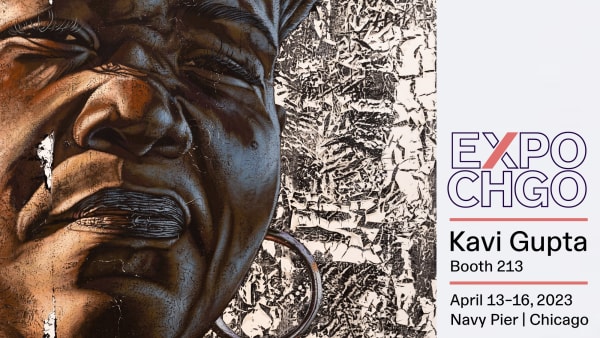
EXPO Chicago 2023
13 - 16 Apr 2023VIP : Thursday, April 13 | 12 PM–9 PM PUBLIC : Friday, April 14 | 11 AM–7 PM Saturday, April 15 | 11 AM–7 PM...Read more -
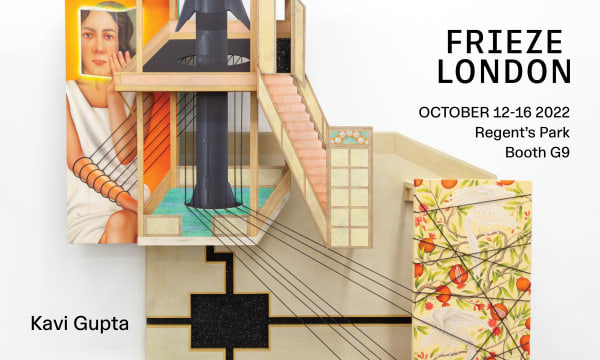
Frieze London 2022
12 - 16 Oct 2022VIP PREVIEW Wednesday, October 12 | 11 AM–7 PM OPENING HOURS Thursday, October 13 | 11 AM–7 PM Friday, October 14 | 11 AM–7 PM...Read more -

EXPO Chicago 2022
7 - 10 Apr 2022It is with great excitement that Kavi Gupta celebrates the return of EXPO Chicago. After almost three years, we are once again able to spotlight...Read more -

Art Basel Miami Beach 2021
2 - 4 Dec 2021For Art Basel Miami Beach 2021, Kavi Gupta presents an array of timely and important works by all of the artists represented in our diverse...Read more -

Frieze London 2021
13 - 17 Oct 2021Kavi Gupta is proud to be participating in the 2021 editions of both Frieze London and Frieze Masters. For Frieze London, we will present a...Read more -

Frieze New York 2021
6 - 9 May 2021For Frieze New York 2021, Kavi Gupta presents an online exhibition highlighting key works from some of today’s most influential contemporary artists. Recent works by...Read more -
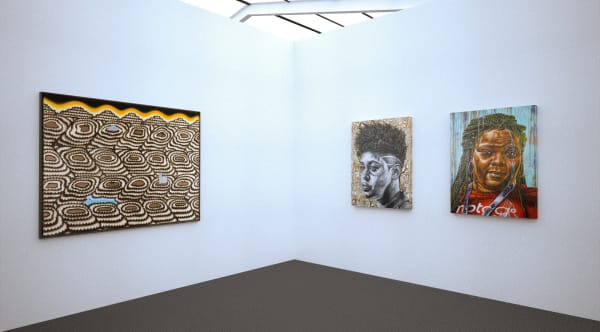
Frieze London 2020
9 - 16 Oct 2020FRIEZE LONDON ONLINE 2020 Kavi Gupta is proud to be part of Frieze London’s 2020 online viewing room. Innovative platforms like this offer us ways...Read more -
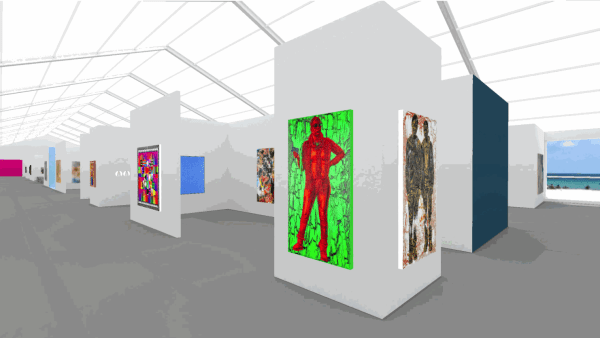
Untitled Art Fair Online 2020
30 Jul - 9 Aug 2020Kavi Gupta is proud to be a participating partner in UNTITLED, ART Online, the world's first VR art fair. Utilizing groundbreaking technology in unprecedented times,...Read more -
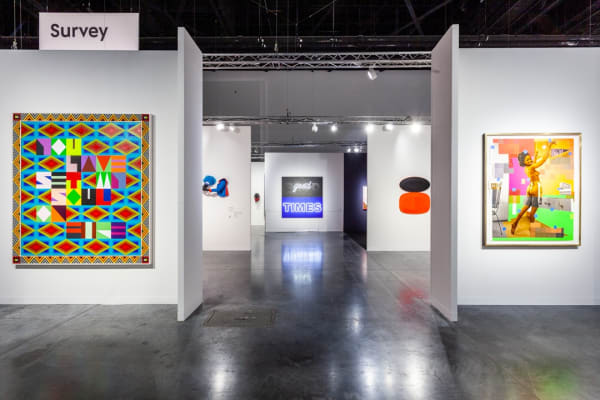
Art Basel Miami Beach 2019
4 - 8 Dec 2019Read more -

The Armory Show 2019
7 - 10 Mar 2019Kavi Gupta is thrilled to participate in the 2019 Armory Fair in New York City. Now in its 26th edition, The Armory Fair is a...Read more -

Felix Art Fair 2019
14 - 17 Feb 2019Kavi Gupta is pleased to be among 38 dealers invited to participate in the inaugural Felix LA art fair, which will take place from February...Read more -

Frieze New York 2019
14 - 17 Feb 2019Kavi Gupta is pleased to participate in Frieze New York. Kavi Gupta Gallery will be located at Booth B22. For more information please contact 312-432-0708.Read more -

Art Basel Miami Beach 2018
6 - 9 Dec 20182018 has been a landmark year for AFRICOBRA (African Commune of Bad Relevant Artists), which was founded in Chicago in 1968 and defined the aesthetic...Read more -

Art Basel Hong Kong 2018
29 - 31 Mar 2018For Art Basel Hong Kong 2018, Kavi Gupta will spotlight new works by a diverse selection of artists, including Beverly Fishman, Manish Nai, Jessica Stockholder,...Read more -

Art Basel Miami Beach 2017
6 - 10 Dec 2017For Art Basel Miami Beach 2017, Kavi Gupta will present an ambitious booth of original work by our distinguished international artists. With an emphasis on...Read more -

EXPO Chicago 2017
13 - 17 Sep 2017Read more
-

Art Collaboration Kyoto 2022 | With KOTARO NUKAGA
Kyoto, Japan 18 - 20 Nov 2022VIP PREVIEW Thursday, November 17 OPENING HOURS Friday, November 18 | 12 PM–7 PM Saturday, November 19 | 12 PM–7 PM Sunday, November 20 |...Read more -

Beverly Fishman Artist Talk
The Contemporary Dayton, Dayton OH 5 May 2022THE DR. ROBERT L. BRANDT, JR. GALLERY Join Beverly Fishman for an artist talk at the Contemporary Dayton on Thursday, May 5 at 6:30 PM....Read more -

Beverly Fishman Artist-led Exhibition Walkthrough: FEELS LIKE LOVE
9 Apr 2022On Saturday, April 9th at 2:00 PM Kavi Gupta hosted Beverly Fishman in an artist-led exhibition walkthrough. Beverly Fishman’s luminescent, geometric relief paintings beguile the...Read more -
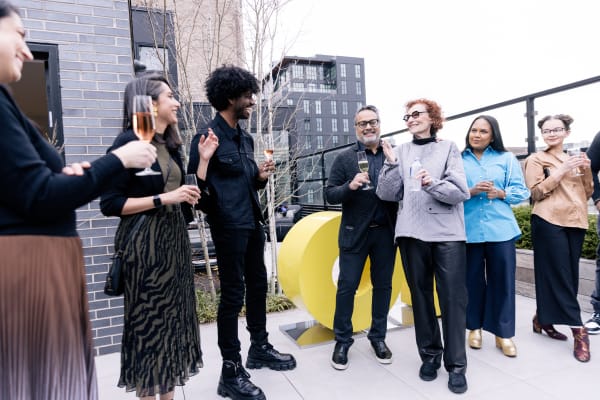
Opening Receptions: Beverly Fishman and Arghavan Khosravi
6 Apr 2022On Wednesday, April 6, 2022 Kavi Gupta Gallery celebrated the openings of two major solo exhibitions, Beverly Fishman: FEELS LIKE LOVE and Arghavan Khosravi: The...Read more
-

Artist Talk: Beverly Fishman and George Rush
The Contemporary Dayton May 9, 2022Watch artists Beverly Fishman and George Rush discuss her current exhibition, CURE , at the Contemporary Dayton in Dayton, OH. 'Beverly Fishman is an American...Read more -

Beverly Fishman @ MSU Broad
January 21, 2022Read more -
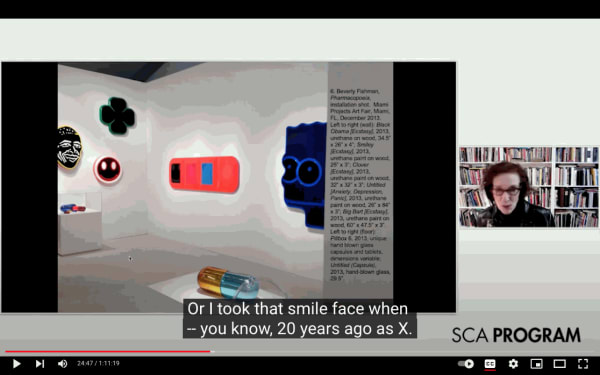
The Society for Contemporary Art presents Beverly Fishman
March 9, 2021Read more -

Beverly Fishman Review: Arts Magazine
October 22, 2020Read more -

Beverly Fishman @ Chrysler Museum of Art
July 16, 2015Read more -
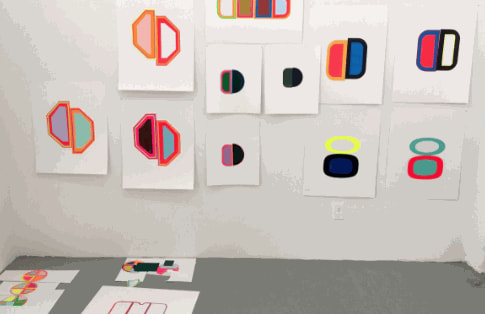
Beverly Fishman - BECon
June 20, 2013Read more
-
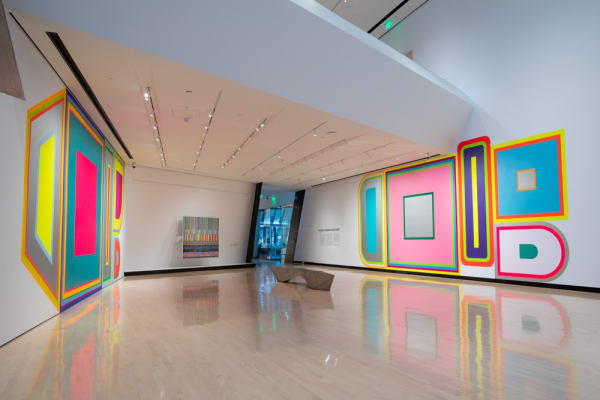
Beverly Fishman | Perceiving Reality in an Alternate Universe
RECOVERY, 2022 at the Eli and Edythe Broad Art Museum August 23, 2022This week marked the closing of Beverly Fishman’s RECOVERY at the Eli and Edythe Broad Art Museum. This exhibition, held in the Julie and Edward...Read more -
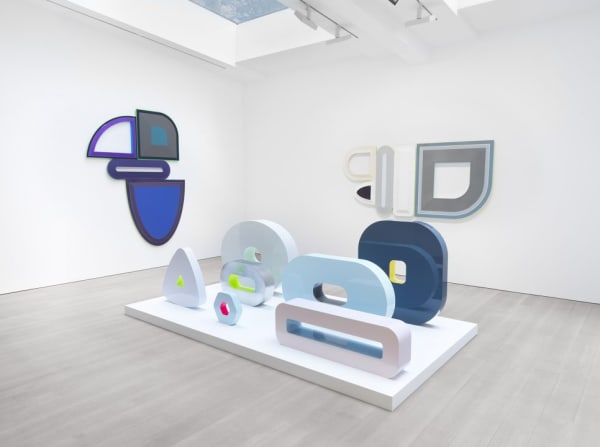
Beverly Fishman on Cool Hunting
October 17, 2020Beverly Fishman is among today’s most beloved abstract artists. Her luminous relief paintings and sculptures have become iconic in their instant recognizability. Her latest body...Read more -

BEVERLY FISHMAN WINS 2018 ANONYMOUS WAS A WOMAN GRANT
12.12.18BEVERLY FISHMAN WINS 2018 ANONYMOUS WAS A WOMAN GRANTRead more -

MEMORIES OF ASPEN ARTCRUSH 2018
08.14.2018Art Crush 2018Read more





